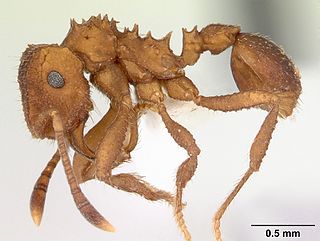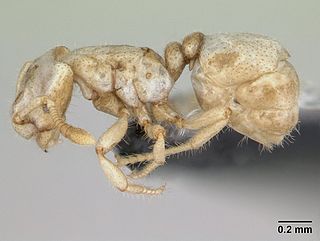
Amyrmex golbachi is a rare Neotropical species of ant and the only known species in the genus Amyrmex. It is currently only known from males from the Amazon basin of Brazil and from northern Argentina.

Leptomyrmex, or spider ants, is a genus of ants and a distinctive member of the ant subfamily Dolichoderinae. Commonly known as "spider ants" for their long legs and spider-like movements, these orange and black ants are prominent residents of intact wet forest and sclerophyll habitats throughout their range. One extant species, Leptomyrmex relictus, is known from central Brazil; otherwise, the global distribution of this genus is restricted to eastern Australia, New Caledonia and New Guinea, as well as the nearby Indonesian islands of Aru and Seram.

Mycocepurus is a Neotropical genus of fungus-growing ants in the subfamily Myrmicinae. The genus is known from Mexico, south to Brazil and Argentina. Like other attines, they primarily grow fungi of the tribe Leucocoprini. They use many different substrates for growing their fungi, from dry leaves and caterpillar dung to fruit matter. One of its species, Mycocepurus smithii, which lives in South America, reproduces by cloning – all ants in a colony are clones of the queen. M. castrator is a parasite of M. goeldii.

Cryptopone is a genus of ants in the subfamily Ponerinae. The genus has a worldwide distribution, with most species occurring in Asia. Workers range from very small to medium in size (1.7–6.1 mm), with the queens being slightly larger.

Atta cephalotes is a species of leafcutter ant in the tribe Attini. A single colony of ants can contain up to 5 million members, and each colony has one queen that can live more than 15 years. The colony comprises different castes, known as "task partitioning", and each caste has a different job to do.

Thaumatomyrmex is a Neotropical genus of ants in the subfamily Ponerinae, found from Mexico to Brazil. They are notable for their pitchfork-shaped mandibles, which they use to capture millipedes of the order Polyxenida. The genus is a specialist predator of polyxenids, and one of only two ant genera known to prey upon polyxenids.

William Montana Mann (1886–1960) was an American entomologist and the fifth director of the National Zoo in Washington, D.C. from 1925 until 1956. In 1921, he traveled on the Mulford Expedition to the Amazon. In 1926, he married Lucile Quarry Mann. The two worked together as a team to improve and promote the zoo, including going on expeditions around the world to collect live specimens for the zoo's collection. He graduated from Washington State University and Harvard University.

Agroecomyrmecinae is a subfamily of ants containing two extant and two fossil genera. The subfamily was originally classified in 1930 by Carpenter as Agroecomyrmecini, a Myrmicinae tribe. Bolton raised the tribe to subfamily status in 2003, suggesting that Agroecomyrmecinae might be the sister taxon to Myrmicinae. It has since been discovered to be one of the earliest lineages of ants, a clade from the basal polytomy for all ants. In 2014, the subfamily was expanded to two tribes. The tribe Ankylomyrmini was moved from the subfamily Myrmicinae to Agroemyrmecinae.

Typhlomyrmex is a genus of ants in the subfamily Ectatomminae and the sole member of the tribe Typhlomyrmecini. Known from the Neotropics, the genus has a wide distribution. Some species are restricted in range, while for example Typhlomyrmex rogenhoferi is known from southern Mexico to northern Argentina. Little is known about their biology. The genus 'Typhlomyrmex' means 'blind ant'. All species of this genus contains only blind ants.

Nomamyrmex is a genus of army ants in the subfamily Dorylinae. Its two species are distributed in the Neotropics: Nomamyrmex esenbeckii is known from southern United States to northern Argentina, and Nomamyrmex hartigii is known from Mexico to southern Brazil. Nomamyrmex esenbeckii is the only known predator of mature colonies of Atta leaf-cutter ants.

Cylindromyrmex is a Neotropical genus of ants in the subfamily Dorylinae.

Blepharidatta is a rare Neotropical genus of ants in the subfamily Myrmicinae. The genus, formed by predatory species whose small colonies nest in soil or leaf-litter, has up to seven species, but most of them are waiting for a formal taxonomic treatment or confirmation.

Daceton is a Neotropical genus of ants in the subfamily Myrmicinae. The genus contains only two species: D. armigerum, the most studied species, distributed throughout northern South America, and D. boltoni, known from Brazil and Peru.

Ochetomyrmex is a Neotropical genus of ants in the subfamily Myrmicinae.

Lachnomyrmex is a Neotropical genus of ants in the subfamily Myrmicinae. The genus consists of 16 species restricted to the Neotropics, known from southern Mexico to northern Argentina. They are most often found in the leaf litter of wet forests, with nests located on the ground. Workers forage alone, apparently without recruiting nestmates or using pheromones. Within the tribe Stenammini, they seem to be most closely related to the genera Lordomyrma of Indo-Australia and Cyphoidris of Africa.

Tropidomyrmex is a Neotropical genus of ants in the subfamily Myrmicinae. The genus contains the single species Tropidomyrmex elianae, known from Brazil.

Myrmelachista is a Neotropical genus of ants in the subfamily Formicinae. The genus is found exclusively in the Neotropical realm. Little is known regarding their biology.

Phalacromyrmex is a Neotropical genus of ants in the subfamily Myrmicinae. It contains the single species Phalacromyrmex fugax, first described from three workers collected in Ibicaré, Santa Catarina, Brazil.

Stegomyrmex is a Neotropical genus of ants in the subfamily Myrmicinae. Strictly Neotropical in its distribution, the genus is known from Costa Rica to northern Argentina. It was once considered rare, but more recent sampling has revealed that the genus is relatively common in the leaf litter.
Kempfidris is a Neotropical genus of ants in the subfamily Myrmicinae containing the single species Kempfidris inusualis. Known from Brazil, Ecuador and Venezuela, the species was originally described as Monomorium inusuale in 2007, but was reclassified as the type species for the new genus Kempfidris in 2014. The species is only known from workers and almost nothing is known about their natural history.



















